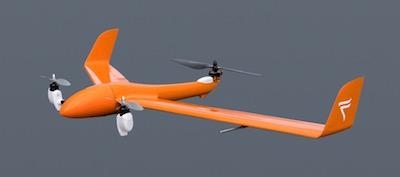Sun, Sep 16, 2018
FlightWave Edge Deployed In Cutting Edge Study Aboard the Schmidt Ocean Institute’s R/V Falkor
The FlightWave Edge UAS was part of a high-tech flotilla of underwater vehicles (AUVs), autonomous surface vessels (ASVs), and unmanned aerial vehicles (UAVs) used on the research ship R/V Falkor in its study of an area of the Pacific Ocean approximately 1,000 miles west of Southern California in an area called the Subtropical Front.

The mission: Establish a new method for observing dynamic ocean systems and processes with autonomous vehicles that maintain constant communication between themselves and a remote control center on the Falkor.
The ecological mysteries of the Subtropical Front are extremely important for scientists to unravel and understand, and also offer a highly valuable opportunity for researchers to experiment with the simultaneous management of multiple autonomous vehicles.
Principal Investigator João Tasso de Figueiredo Borges de Sousa of the Laboratório de Sistemas e Tecnologias Subaquáticas (LSTS) from Porto University and his team are leading the effort, along with researchers from the Interdisciplinary Centre of Marine and Environmental Research (CIIMAR), a leading research and advanced training institution of the University of Porto in Portugal; Technical University of Cartagena in Spain; Norwegian University of Science and Technology in Norway; and U.S. researchers from Harvard, University of Rhode Island, and Lamond-Doherty Observatory.
The Edge worked as part of a system of autonomous marine vehicles to map out ocean fronts. Researchers will use it to try out three types of sensors: a thermal camera to measure sea surface temperature, a multispectral camera to detect plankton, and a special sensor made by NASA that measures a gas called DMS emitted by plankton.
“Operating from a ship out in the middle of nowhere enables us to demonstrate the Edge’s versatility and airworthiness,” said FlightWave co-founder and CTO Trent Lukaczyk, Ph.D. — who is part of the team at sea. “And there’s only one good place to land: back on the ship. The Edge’s VTOL and payload swapping are important capabilities out here. And networking into a system of autonomous assets via the Falkor’s network and supercomputer puts this demo on a whole new level.”
(Source: FlightWave news release. Image from FlightWave website)
More News
Aero Linx: International Federation of Airworthiness (IFA) We aim to be the most internationally respected independent authority on the subject of Airworthiness. IFA uniquely combi>[...]
Ultrahigh Frequency (UHF) The frequency band between 300 and 3,000 MHz. The bank of radio frequencies used for military air/ground voice communications. In some instances this may >[...]
A Few Questions AND Answers To Help You Get MORE Out of ANN! 1) I forgot my password. How do I find it? 1) Easy... click here and give us your e-mail address--we'll send it to you >[...]
From 2019 (YouTube Edition): Learning To Paint Without Getting Any On Your Hands PPG's Aerospace Coatings Academy is a tool designed to teach everything one needs to know about all>[...]
Also: Sustainable Aircraft Test Put Aside, More Falcon 9 Ops, Wyoming ANG Rescue, Oreo Cookie Into Orbit Joby Aviation has reason to celebrate, recently completing its first full t>[...]
 ANN's Daily Aero-Linx (05.06.25)
ANN's Daily Aero-Linx (05.06.25) ANN's Daily Aero-Term (05.06.25): Ultrahigh Frequency (UHF)
ANN's Daily Aero-Term (05.06.25): Ultrahigh Frequency (UHF) ANN FAQ: Q&A 101
ANN FAQ: Q&A 101 Classic Aero-TV: Virtual Reality Painting--PPG Leverages Technology for Training
Classic Aero-TV: Virtual Reality Painting--PPG Leverages Technology for Training Airborne 05.02.25: Joby Crewed Milestone, Diamond Club, Canadian Pilot Insurance
Airborne 05.02.25: Joby Crewed Milestone, Diamond Club, Canadian Pilot Insurance



